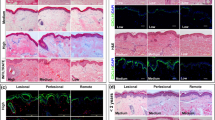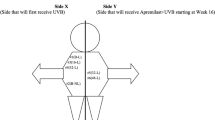Abstract
There is a growing evidence that cytokines are important in the depigmentation process of vitiligo, however, the exact mechanism is not fully understood. The aim of this work was to study the possible role of the tumor necrosis factor-α (TNF-α) cytokine in the depigmentation process of the disease. Twenty patients with generalized vitiligo were exposed to narrow-band ultraviolet B (NB-UVB) therapy thrice weekly for a total of 60 sessions. Immunohistochemical examination was done, to assess the TNF-α expression in lesional and perilesional skin as compared to normal control skin, before and after therapy. At baseline, positive lesional TNF-α expression was detected in 60 % of patients which was significantly higher as compared to perilesional skin (20 %) and negative expression in healthy control skin. Post-treatment, a statistically significant increase in TNF-α expression was detected in both lesional (90 %) and perilesional skin (70 %) as compared to baseline (P < 0.05). The significant increase of TNF-α in vitiligo lesions compared with perilesional and healthy skin suggests a possible involvement of this cytokine in the depigmentation of vitiligo. The increase in TNF-α expression after NB-UVB phototherapy suggests another role in repigmentation.





Similar content being viewed by others
References
Arca E, Tastan HB, Erbil AH et al (2006) Narrow band ultraviolet B as monotherapy and in combination with topical calcipotriol in the treatment of vitiligo. J Dermatol 33:338–343
Birol A, Kisa U, Kurtipek GS et al (2006) Increased tumour necrosis factor alpha (TNF-α) and interleukin 1 alpha (IL-1α) levels in the lesional skin of patients with nonsegmental vitiligo. Int J Dermatol 45:992–993
Brazzelli V, Antoninetti M, Palazzini S et al (2007) Critical evaluation of the variants influencing the clinical response of vitiligo: study of 60 cases treated with NB-UVB phototherapy. J Eur Acad Dermatol Venereol 21:1369–1374
Brink N, Szamel M, Young AR et al (2000) Comparative quantification of IL-1β, IL-10, TNF-α and IL-7 mRNA levels in UV irradiated skin in vivo. Inflamm Res 49:290–296
Cui J, Shen LY, Wang GC (1991) Role of hair follicles in the repigmentation of vitiligo. J Invest Dermatol 97:410–416
Eves PC, Bullett NA, Haddow D et al (2008) Simplifying the delivery of melanocytes and keratinocytes for the treatment of vitiligo using a chemically defined carrier dressing. J Invest Dermatol 128(6):1554–1564
Fitzpatrick TB (1997) Mechanisms of phototherapy in vitiligo. Arch Dermatol 133:1591–1592
Goktas EO, Aydin F, Senturk N et al (2006) Combination of narrow band UVB and topical calcipotriol for the treatment of vitiligo. J Eur Acad Dermatol Venereol 20:553–557
Grimes PE, Morris R, Avaniss-Aghajani T et al (2004) Topical tacrolimus therapy for vitiligo. Therapeutic responses and skin messenger RNA expression of proinflammatory cytokines. J Am Acad Dermatol 51(1):52–61
Hamzavi I, Jain H, McLean D et al (2004) Parametric modeling of narrow band UV-B phototherapy for vitiligo using a novel quantitative tool. Arch Dermatol 140:677–683
Hino R, Kobayashi T, Mori H et al (2007) Inhibition of T helper 2 chemokine production by narrow-band ultraviolet B in cultured keratinocytes. Br J Dermatol 156:830–837
Joshi PG, Nair N, Begum G et al (2007) Melanocyte-keratinocyte interaction induces calcium signalling and melanin transfer to keratinocytes. Pigment Cell Res 20(5):380–384
Kang HY, Kang WH (2004) Leukomelanoderma following acute cutaneous graft-versus-host disease. Eur J Dermatol 14(3):146–149
Kawaguchi M, Mitsuhashi Y, Kondo S (2005) Over expression of tumor necrosis factor α-converting enzyme in psoriasis. Br J Dermatol 152(5):915–919
Köck A, Shwarz T, Kirnbauer R et al (1990) Human keratinocytes are a source for tumour necrosis factor α: evidence for synthesis and release upon stimulation with endotoxin or ultraviolet light. J Exp Med 172:1609–1614
Leverkus M, Yaar M, Eller MS et al (1998) Post transcriptional regulation of UV induced TNF-alpha expression. J Invest Dermatol 110:353–357
Lowry OH, Rosebrough NJ, Farr AL et al (1951) Protein measurement with Folin phenol reagent. J Biol Chem 193:265–275
Martinez-Esparzo M, Jimenez-Cervantes C, Solano F et al (1998) Mechanisms of melanogenesis inhibition by tumour necrosis factor-α in melanoma cells. Eur J Biochem 255:139–146
Moretti S, Spallanzani A, Amato L et al (2002) New insights into the pathogenesis of vitiligo: imbalance of epidermal cytokines at sites of lesions. Pigment Cell Res 15:87–92
Njoo MD, Bos JD, Westerhof W (2000) Treatment of generalized vitiligo in children with narrow band (TL-01) UVB radiation therapy. J Am Acad Dermatol 42:245–253
Scherschun L, Kim JJ, Lim HW (2001) Narrow band ultraviolet-B is a useful and well tolerated treatment for vitiligo. J Am Acad Dermatol 44(6):999–1003
Schwarz A, Maeda A, Wild MK et al (2004) Ultraviolet radiation induced regulatory T cells not only inhibit the induction but can suppress the effector phase of contact hypersensitivity. J Immunol 172:1036–1043
Schwarz T (2002) Photoimmunosuppression. Photodermatol Photoimmunol Photomed 18:141–145
Seité S, Colige A, Deroanne C et al (2004) Changes in matrix gene and protein expressions after single or repeated exposure to one minimal erythemal dose of solar-stimulated radiation in human skin in vivo. Photochem Photobiol 79:265–271
Shang J, Eberle J, Geilen CC et al (2002) The role of nuclear factor-kappa B and melanogenesis in tumor necrosis factor-alpha-induce. Skin Pharmacol Appl Skin Physiol 15:321–329
Shintani Y, Yasuda Y, Kobayashi K et al (2008) Narrow band UVB radiation suppresses contact hypersensitivity. Photodermatol Photoimmunol Photomed 24:32–37
Skov L, Hansen H, Allen M et al (1998) Contrasting effects of ultraviolet A1 and ultraviolet B exposure on the induction of tumour necrosis factor alpha in human skin. Br J Dermatol 138:216–220
Wallace ML, Smoller BR (1996) Immunohistochemistry in diagnostic dermatopathology. J Am Acad Dermatol 34(2):163–183
Westerhof W, d’ Ischia M (2007) Vitiligo puzzle, the pieces fall in place. Pigment Cell Res 20(5):345–359
Conflict of interest
None declared.
Author information
Authors and Affiliations
Corresponding author
Rights and permissions
About this article
Cite this article
Attwa, E., Gamil, H., Assaf, M. et al. Over-expression of tumor necrosis factor-α in vitiligo lesions after narrow-band UVB therapy: an immunohistochemical study. Arch Dermatol Res 304, 823–830 (2012). https://doi.org/10.1007/s00403-012-1269-6
Received:
Revised:
Accepted:
Published:
Issue Date:
DOI: https://doi.org/10.1007/s00403-012-1269-6




